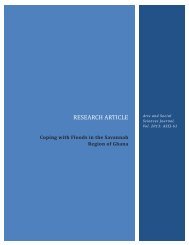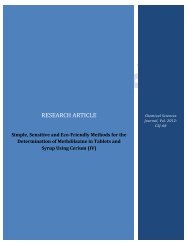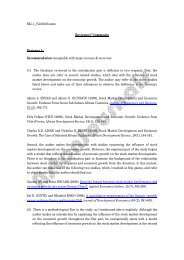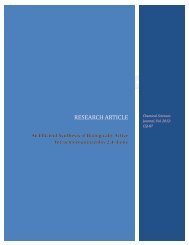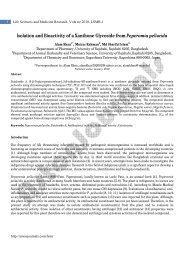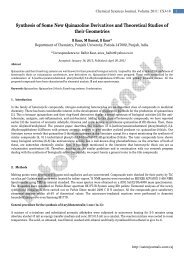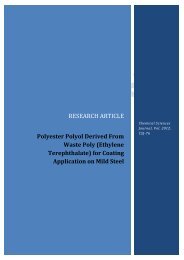Micellisation of Cetyltrimethyl Ammonium Bromide ... - AstonJournals
Micellisation of Cetyltrimethyl Ammonium Bromide ... - AstonJournals
Micellisation of Cetyltrimethyl Ammonium Bromide ... - AstonJournals
- No tags were found...
You also want an ePaper? Increase the reach of your titles
YUMPU automatically turns print PDFs into web optimized ePapers that Google loves.
RESEARCH ARTICLEChemical SciencesJournal, Vol. 2012:CSJ-52<strong>Micellisation</strong> <strong>of</strong> <strong>Cetyltrimethyl</strong> <strong>Ammonium</strong> <strong>Bromide</strong> inAqueous-Organic Media
2 Research Articleconstant, and (iii) a high hydrogen-bonding ability. It has been proposed [19] that the capability <strong>of</strong> hydrogenbond formation is one <strong>of</strong> the most necessary conditions for the self-assembly <strong>of</strong> surfactants. Addition <strong>of</strong> polarorganic solvents to aqueous micellar solutions will alter the tendency <strong>of</strong> amphiphile molecules to avoid contactwith the solvent, and therefore, it is expected to affect the value <strong>of</strong> surfactant concentration at whichmicellisation occurs, i.e. critical micelle concentration (CMC), as well as micelles characteristics such as thecounter ion dissociation constant.A temperature <strong>of</strong> maximum stability for protein native structure and a temperature <strong>of</strong> minimum forthe CMC <strong>of</strong> ionic surfactants [20] are widely reported in the literature. It is reasonable to think that theseeffects correspond to variations with temperature <strong>of</strong> the hydration <strong>of</strong> hydrophobic groups and hydrophobicinteractions. While hydrophobic interactions were thought for a long time a major contribution to themicellisation, major emphasis in recent studies has been placed on London-dispersion interactions. Argumentsfor the relative importance <strong>of</strong> the various interactions on the micellisation process can only be obtained fromcomprehensive studies <strong>of</strong> thermodynamic properties <strong>of</strong> the complicated process <strong>of</strong> micellisation in whichsurfactant alkyl chains, surfactant head groups, counterions, and surrounding medium all play important role.In particular, micellisation parameters related to micellar conductance at different temperature need moreattention.Since the majority <strong>of</strong> the work reported in the mixed-solvent systems was done only at a few selectedcompositions <strong>of</strong> the organic solvents, a study in which the compositions <strong>of</strong> the mixed systems are varied andthermodynamic parameters studies shall be investigated conductiometrically in mixed EG + water,DMSO + water, and DMF + water. This will give an insight about the selection <strong>of</strong> mixed-solvent systems fortheir use in enhanced oil recovery, pharmaceutical and cosmetic applications, washings, and chemicalreactions.2. MethodsFigure 1: Schematic representation <strong>of</strong> CTABr molecular structure.2.1. Materials<strong>Cetyltrimethyl</strong>ammonium bromide (CTABr) was procured from Sigma. All the solvents used (EG, DMSO, andDMF) were obtained from Central Drug House (Bombay, India) and were <strong>of</strong> highest purity (99.9%), usedwithout further purification.2.2. Determination <strong>of</strong> critical micelle concentration (CMC)Conductometric measurements were carried out with a digital systronics conductivity meter (306) modelconnected to a water flow thermostat at a frequency <strong>of</strong> 200 Hz using a dip-type cell <strong>of</strong> cell constant 1.0 cm -1 .The cell was calibrated with KCl solutions in the approximate concentration range. Initially, 10 mL <strong>of</strong> thereference solution (i.e., water) or an appropriate amount <strong>of</strong> each additive in water was taken in theconductivity cell and equilibrated at specified temperature for 1 hr before starting the experiment. A knownconcentration <strong>of</strong> CTABr, made with the same reference solution, was then added from a micropipette andequilibrated until the conductivity value became constant. In this way, the precise conductance <strong>of</strong> CTABr inEG + Water, DMSO + Water, and DMF + Water, mass fraction were determined. The error in the conductancemeasurements was ±0.5%.2.3. Theoretical backgroundThe standard states are defined for the free surfactant and the micelle state. For the free surfactant, the unitactivity is taken as the standard state. While for micelle surfactant, the micelle state is considered as thestandard state. The free surfactants in solution are assumed to be in equilibrium with the surfactants in themicelle phase. Thus, is the chemical potential <strong>of</strong> the free surfactants and , is the chemical potential <strong>of</strong>sthe surfactants in the micelle. Since the chemical potential for the free surfactant in solution and the chemicalpotential in micellar phase are in equilibrium.mhttp://astonjournals.com/csj
Chemical Sciences Journal, Vol. 2012: CSJ-523Thens m(1)If the solution is ideal, the chemical potential for the free surfactant in solution at fixed temperatureand pressure is given byos s RT ln as(2)For surfactant in the micellar phase, the chemical potential is equivalent to the standardthermodynamic properties ( ) at equilibrium. Thereforeomom m(3)At equilibrium,oos RTln as m(4)ando o oGm m s RT ln as(5)owhere G mis the Gibb’s energy <strong>of</strong> micellisation and asis the activity <strong>of</strong> the free surfactant in solution, R isthe gas constant and T, the temperature.oBased on the phase separation model for ionic surfactant, for the calculated G m, it is necessary toconsider not only the transfer <strong>of</strong> surfactant molecules but also the transfer <strong>of</strong> moles <strong>of</strong> counterions (1 - ),where is the degree <strong>of</strong> counterions dissociation.Therefore, at equilibriumoG RT ln a (1 ) RT ln a (6)m s Brwhere a Br is the activity <strong>of</strong> the counterions. Then, equation (6) can be written asoGm (2 ) RT ln acmc(7)wherea cmc is the mean activity <strong>of</strong> the counterions at the CMC.For most thermodynamic studies on the micellisation <strong>of</strong> ionic surfactantsby X cmc . As given in the following equation.oGm (2 ) RT ln Xcmc(8)ln X [cmc]/ c , and C is the mole <strong>of</strong> the solvent per dm 3 .a cmchas been replacedwhere cmcThe enthalpy <strong>of</strong> micellisation can be obtained from the temperature dependence <strong>of</strong> the CMC byapplying the Gibbs–Helmholtz equation [23].Hom2 oT ( Gm/ T) (9)Tln XIn order to do this, the cmc and the values are fitted to the polynomial equations (10) and(11) as presented below.2ln Xcmc( T) a b( T / K) c( T / K)(10)( T) d e( T / K)(11)In the above equations a, b, c, d and e are determined by least square regression analysis. isthen calculated numerically by substituting equations (10) and (11) into equation (9). Once the Gibbs–freeenergy and the enthalpy <strong>of</strong> micelle formation are obtained, then the entropy <strong>of</strong> micelle formation can bedetermined using the equation below.oH mhttp://astonjournals.com/csj
4 Research Articleo o o 1 S ( )m m Gm (12)T3. Results and DiscussionThe pr<strong>of</strong>ile <strong>of</strong> the conductance reading versus the varying concentration <strong>of</strong> CTABr gave a curve with twodifferent slopes. The data above and below the region, in which there is a rapid change <strong>of</strong> slope, were fixed bylinear regression and the CMC was taken as the point <strong>of</strong> intersection. The degree <strong>of</strong> counterion dissociation ( ) was obtained from the ratio <strong>of</strong> the slope in post-micelle (S 2 ) and that <strong>of</strong> the pre-micelle region (S 1 ) [21].The CMC <strong>of</strong> CTABr in water increased with increase in temperature from 8.63 x 10 -4 at 293.1 K to 1.22 x 10 -3mol dm -3 at 313.1 K. Addition <strong>of</strong> different mass fraction <strong>of</strong> co-solvent (17–47) to water at differenttemperature also increased the value <strong>of</strong> CMC as shown in Table 1.Table 1: The CMC for CTABr in different aqueous-organic media at various temperatures.10 -2. sCo-solventTemperature (K)293.1 298.1 303.1 308.1 313.1Critical Micelle Concentration (mol dm -3 ) ± 0.50Water 8.63 x 10 -4 9.50 x 10 -4 1.07 x 10 -3 1.14 x 10 -3 1.22 x 10 -3EG–Water17 1.08 x 10 -3 1.27 x 10 -3 1.35 x 10 -3 1.47 x 10 -3 1.63 x 10 -327 1.57 x 10 -3 1.67 x 10 -3 1.74 x 10 -3 1.95 x 10 -3 2.25 x 10 -337 1.61 x 10 -3 1.75 x 10 -3 1.87 x 10 -3 2.15 x 10 -3 2.40 x 10 -347 2.53 x 10 -3 2.61 x 10 -3 2.70 x 10 -3 2.90 x 10 -3 3.12 x 10 -3DMSO–Water17 1.32 x 10 -3 1.53 x 10 -3 1.68 x 10 -3 1.86 x 10 -3 1.97 x 10 -327 1.92 x 10 -3 1.98 x 10 -3 2.20 x 10 -3 2.38 x 10 -3 2.42 x 10 -337 2.80 x 10 -3 2.98 x 10 -3 3.18 x 10 -3 3.24 x 10 -3 3.52 x 10 -347 3.73 x 10 -3 4.00 x 10 -3 4.26 x 10 -3 4.58 x 10 -3 4.88 x 10 -3DMF–Water17 2.20 x 10 -3 2.45 x 10 -3 2.63 x 10 -3 3.00 x 10 -3 3.25 x 10 -327 3.93 x 10 -3 4.20 x 10 -3 4.55 x 10 -3 5.15 x 10 -3 5.45 x 10 -337 5.55 x 10 -3 6.00 x 10 -3 7.53 x 10 -3 8.92 x 10 -3 1.02 x 10 -247 1.35 x 10 -2 1.55 x 10 -2 1.75 x 10 -2 1.97 x 10 -2This showed that the value <strong>of</strong> CMC increased with increase in temperature within the temperaturerange investigated. The effect <strong>of</strong> temperature on the CMC <strong>of</strong> surfactant in aqueous solution has been analysedin terms <strong>of</strong> two opposing factors. First, as the temperature increases, the degree <strong>of</strong> hydration <strong>of</strong> thehydrophilic group decreases, which favours micellisation, however, an increase in temperature also causes thedisruptions <strong>of</strong> the water structure surrounding the hydrophobic group and this is unfavourable to micellisation[22]. The results presented in Table 1 revealed that second effect predominated within the temperature rangestudied. Also that micellisation is unfavourable in the presence <strong>of</strong> EG, DMSO, and DMF. EG being a waterstructure breaker decreases the hydrophobic interaction due to the decrease in cohesive energy and dielectricconstant. These properties <strong>of</strong> EG enabled it to increase the solubility <strong>of</strong> the hydrocarbon chain <strong>of</strong> the CTABrmonomer which made it difficult for the hydrocarbon chain to aggregate and the fewer hydrocarbonsaggregated occurred at higher concentration <strong>of</strong> CTABr. The same trend was observed in the case <strong>of</strong> DMSO–water and DMF–water. The delay in micellisation in the case <strong>of</strong> DMSO and DMF can be justified by taking intoconsideration the increased structuring <strong>of</strong> the H 2 O–DMSO and H 2 O–DMF liquid system. Both DMSO and DMFare known to form stoichiometric hydrate with water <strong>of</strong> the type DMSO.H 2 O and DMF.H 2 O. The hydrateformation substantially restricted the motion <strong>of</strong> the surfactant molecule, which ultimately leads to reduction inhttp://astonjournals.com/csj
Chemical Sciences Journal, Vol. 2012: CSJ-525hydrophobic interaction and an increase in CMC. It is noteworthy that the dielectric constant <strong>of</strong> DMSO andDMF are 48.9 and 36.7 respectively, and this played a prominent role in the micellisation <strong>of</strong> CTABr. Addition <strong>of</strong>more DMSO and DMF to the binary system decreased the dielectric constant <strong>of</strong> the medium further and sincesolvent with low dielectric constant, i.e., polarity usually solubilised organic molecules more easily [23] thanthose with high polarity, the mutual repulsion between ionic head in the micelle increased, hence an increasein the magnitude <strong>of</strong> CMC. Representative plot <strong>of</strong> the dependence <strong>of</strong> CMC on the co-solvent mass fraction atvarying temperature is shown in Figure 2.Figure 2: Plot <strong>of</strong> log([cmc]/moldm -3 ) against the mass fraction ( ) <strong>of</strong> the organic solvent at 293.1 K (♦ = EG +Water, ■ = DMSO + Water, ▲ = DMF + Water).sA linear relationship between log [(CMC)]/mol dm -3 versus mass fraction <strong>of</strong> the co-solvent wasobserved. This finding was in agreement with the data presented by other workers [21, 24, 25]. Thisrelationship is represented by the following equation:3 3log([(CMC]mix/ moldm ) log([CMC] aq/ moldm ) KWs(13)where the subscript, mix, represents the value <strong>of</strong> log ([CMC]/mol dm -3 ) in co-solvent free medium; W s , is themass fraction <strong>of</strong> the co-solvent and K is a constant which is a measure <strong>of</strong> the hydrophobic character <strong>of</strong> the cosolvent[21]. The values <strong>of</strong> counterion dissociation ( ) obtained at different mass fraction <strong>of</strong> co-solvent atvarying temperature are presented in Table 2.This increase in the value <strong>of</strong> as mentioned above could be attributed to the columbic and thermalforces [26]. The former force attracts surfactant head groups while the latter disperses the surfactant headgroups. The thermal forces predominated the columbic forces, and this led to an increase in the separationbetween the counterions and the head groups, hence increased α value. Increase in the values <strong>of</strong> CMC and ,as the mass fraction <strong>of</strong> co-solvent EG, DMSO, and DMF increased can be explained by considering the solventdependentcontributions to the free energy <strong>of</strong> micellisation (6) viz. (i) the aggregate core–solvent interfacialenergy, (ii) the head group interactions Gibbs energy, and (iii) the surfactant tail transfer Gibbs energy, whichgives rise to solvophobic effect. The magnitude <strong>of</strong> the surfactant tail transfer Gibbs energy is smaller for EG,DMSO, and DMF when compared with that for water.http://astonjournals.com/csj
6 Research ArticleTable 2: Counterions dissociation (α) for CTABr in aqueous-organic media at different temperatures.10 -2 sTemperature (K)Co-solvent293.1 298.1 303.1 308.1 313.1Degree <strong>of</strong> Counterions dissociation (α)Water 0.328 0.336 0.348 0.363 0.383EG–Water17 0.355 0.360 0.369 0.376 0.38127 0.420 0.419 0.426 0.433 0.44337 0.330 0.340 0.351 0.370 0.38347 0.451 0.470 0.507 0.526 0.560DMSO–Water17 0.304 0.307 0.310 0.317 0.32227 0.300 0.309 0.330 0.350 0.36537 0.290 0.341 0.364 0.411 0.44147 0.432 0.480 0.523 0.592 0.630DMF–Water17 0.323 0.348 0.371 0.392 0.42227 0.374 0.420 0.451 0.491 0.54337 0.671 0.681 0.714 0.743 0.76247 0.700 0.741 0.793 0.811 -The ( ) value increased as the temperature increased (Figure 3).Figure 3: The plot <strong>of</strong> degree <strong>of</strong> counterions <strong>of</strong> dissociation (α) against temperature in 0.17 mass fraction ( )<strong>of</strong> organic solvent (♦ = EG + Water, ■ = DMSO + Water, ▲ = DMF + Water).shttp://astonjournals.com/csj
Chemical Sciences Journal, Vol. 2012: CSJ-5273.1. Thermodynamics <strong>of</strong> micellisationThe dependence <strong>of</strong> CMC on solution temperature was used to evaluate the standard thermodynamicparameters <strong>of</strong> micellisation <strong>of</strong> CTABr in mixed-solvent systems. The change in the CMC value with temperatureis generally analysed in terms <strong>of</strong> the phase separation or equilibrium model for micelle formation. <strong>Micellisation</strong>takes place where the energy <strong>of</strong> dissociation <strong>of</strong> hydrocarbon chain <strong>of</strong> the monomer is sufficient to overcomethe electrical repulsion between the ionic head groups and the decrease in entropy accompanying theaggregation [27].All the thermodynamic parameters <strong>of</strong> micellisation at 0.17, 0.27, 0.37, and 0.47 mass fraction <strong>of</strong> cosolventare presented in Tables 3–5. The values are negative since thermodynamically stable micelleoareG mformed spontaneously while the little change in thermodynamic parameter as temperature changes in thebinary system signified that the process <strong>of</strong> micellisation was less spontaneous in nature.oThe value <strong>of</strong> also varied with temperature as represented in Table 3 on addition <strong>of</strong> EG, DMSO,G moand DMF as co-solvent. However, the less negativity was observed in for CTABr upon addition <strong>of</strong> organicsolvents is mainly determined by the increase in the CMC when the organic solvent content increases. This canbe explained in terms <strong>of</strong> the transfer <strong>of</strong> the surfactant tail from the bulk phase into the micellar core and that<strong>of</strong> the alkyl chains in the head groups from the bulk phase into the micellar surface (or deeper if the chains aresufficiently long) are less spontaneous when the amount <strong>of</strong> organic solvent in the mixture increased. For thisoreason, and taking into account the values listed in Tables 3, one can infer that for CTABr, the additionG m<strong>of</strong> organic solvents which remain principally located in the bulk phase makes the micellisation process lessspontaneous [28, 29].G mTable 3:10 -2 sCo-solvento G mfor CTABr in different aqueous-organic media at various temperatures.Temperature (K)293.1 298.1 303.1 308.1 313.1 Change in Gibb’s Free Energy (KJ mol -1 )oG mWater -45.36 -45.30 -45.25 -45.21 -45.16EG–Water17 -44.90 -43.84 -43.24 -43.10 -42.3727 -40.15 -39.80 -38.80 -38.42 -37.9637 -41.99 -41.23 -41.10 -40.85 -40.7247 -36.83 -36.20 -35.71 -35.13 -34.97DMSO–Water17 -43.80 -43.53 -43.40 -43.20 -44.1227 -42.64 -41.89 -41.58 -41.42 -41.2437 -39.67 -38.86 -38.69 -38.13 -37.6847 -34.70 -33.95 -33.31 -33.45 -31.43DMF–Water17 -40.72 -40.36 -40.17 -39.17 -39.3327 -36.65 -35.96 -35.54 -34.71 -33.8437 -28.85 -28.35 -27.37 -26.65 -26.2447 -23.85 -23.14 -22.43 -21.41 -oThe negative H mvalues are evidence that London – dispersion interactions represents the majoroattractive force for micellisation and that micellisation proceeded via an exothermic process [30]. The value for CTABr–water-co-solvent system was positive, indicating that the micellisation process is favoured byentropy gain as observed in Table 5. Large positive value <strong>of</strong> entropy in the binary system dictated therandomness after micellisation and this clearly showed that the micellisation <strong>of</strong> CTABr in the binary system isS mhttp://astonjournals.com/csj
8 Research Articlegoverned mainly by hydrophobic interaction between the surfactant hydrophobic part and the organicmolecule mixture resulting in the total breakdown <strong>of</strong> the water structure surrounding the hydrophobic groupas they transfer from aqueous bulk phase to non-aqueous micellar interior.10 -2 sCo-solventTable 4: for CTABr in different aqueous-organic media at various temperatures.oH mTemperature (K)293.1 298.1 303.1 308.1 313.1oChange in Enthalpy <strong>of</strong> <strong>Micellisation</strong> ( ) (KJ.Mol -1 )± 0.50Water -5.00 -1.00 -3.00 -7.00 -13.00EG–Water17 -38.40 -35.90 -33.60 -30.60 -26.8027 -9.00 -17.00 -25.00 -34.00 -45.0037 -30.00 -37.00 -40.00 -46.00 -52.0047 -45.00 -50.00 -56.00 -60.00 -63.00DMSO–Water17 -38.10 -37.10 -36.20 -40.50 -39.9027 -42.50 -41.80 -42.00 -42.00 -41.6037 -67.34 -68.00 -68.00 -69.27 -70.0047 -79.40 -81.50 -83.50 -85.70 -87.70DMF–Water17 -58.00 -58.00 -60.00 -62.00 -63.0027 -73.50 -75.40 -77.30 -79.00 -81.7037 -88.50 -81.90 -84.30 -85.70 -67.0047 -99.00 -95.00 -93.00 -90.00 -H m10 -2 sCo-solventTable 5: for CTABr in different aqueous-organic media at various temperatures.oS mTemperature (K)293.1 298.1 303.1 308.1 313.1oChange in Entropy <strong>of</strong> <strong>Micellisation</strong> (J Mol -1 K -1 )Water 136.81 148.81 139.26 169.59 185.76EG–Water17 15.35 23.28 31.24 41.03 52.9227 103.54 76.48 49.92 19.96 38.4537 37.50 13.75 4.06 16.72 36.0647 31.29 46.29 60.34 80.72 89.52DMSO–Water17 16.04 11.98 8.25 2.27 7.0927 3.00 1.00 1.39 0.58 0.7737 94.40 97.75 96.70 101.07 103.2347 112.51 129.51 135.59 149.57 159.72DMF–Water17 58.96 59.17 65.42 72.15 75.6027 125.73 132.30 137.78 143.75 152.8637 103.10 112.55 121.84 126.74 130.1847 85.81 73.33 67.87 60.33 -S mhttp://astonjournals.com/csj
Chemical Sciences Journal, Vol. 2012: CSJ-529The variation <strong>of</strong> values with temperature as shown in Figure 4 could be ascribed to change inoH mthe hydration <strong>of</strong> the head groups during micellisation.oFigure 4: The change in enthalpy ( H mKJ mol -1 ) against temperature in 0.17 mass fraction ( s) <strong>of</strong> organicsolvent (♦ = EG + Water, ■ = DMSO + Water; ▲ = DMF + Water).oThe magnitude <strong>of</strong> is lower in the presence <strong>of</strong> co-solvent than in the absence <strong>of</strong> co-solvent. ThisS msuggested that the solvents still controlled the three-dimensional water matrix, indicating that theomicellisation process <strong>of</strong> the studied surfactant is exothermic though the positive values <strong>of</strong> , are due tothe melting <strong>of</strong> flickering cluster” around hydrocarbon ends <strong>of</strong> the surfactant monomer and the increaserandomness <strong>of</strong> the hydrocarbon chains in the micelle core. The amphiphilic monomers with a longhydrocarbon chain increased the orderliness <strong>of</strong> water by the formation <strong>of</strong> a Frank-Evan iceberg around thehydrocarbon chain which resulted in a decrease in the entropy <strong>of</strong> the system.4. ConclusionThe micellisation <strong>of</strong> the cationic surfactant CTABr in EG, DMSO, and DMF binary mixture was investigated byconductivity measurement over temperature range <strong>of</strong> 298.1–313.1 K. The CMC and degree <strong>of</strong> counteriondissociation ( ) values increased with increase in the amount <strong>of</strong> EG, DMSO, and DMF. Addition <strong>of</strong> organicsolvents to the CTAB–water system made the micellisation process less spontaneous. The London-dispersioninteraction represented the major attraction force for micellisation that proceeded via an exothermic process.The micellisation in CTAB–water-co-solvent system is favoured by entropy gain.Competing InterestsAuthors do not have any competing interests.Authors’ ContributionsSE developed, carried out and analysed data; NA, IA, and CO supervised the preparation <strong>of</strong> the manuscript;MO assisted with the preparation <strong>of</strong> the manuscript.S mhttp://astonjournals.com/csj
10 Research ArticleAcknowledgementThe authors acknowledge the management <strong>of</strong> Chemistry Laboratory <strong>of</strong> Adekunle Ajasin University, Akungba-Akoko, Nigeria for the provision <strong>of</strong> all the material needed for this work.References[1] Mayers D, 1998. Surfactant Science and Technology. New York: UCH.[2] Rosen MJ, 2004. Surfactant and Interfacial Phenomena. New York: Wiley.[3] Alessandro DM, Lucia B, Pietro DP, et al., 2011. Effect <strong>of</strong> head group size, temperature and counterionspecificity on cationic micelles. Journal <strong>of</strong> Colloid and Interface Science, 358: 160–166.[4] Akhter MS, Alawi SM, Bose AN, 1995. Micelle formation in molten acetamide. Colloid Surfaces A, 94:173–176.[5] Ramadan MS, Evan DF, Lumry R, 1983. Why micelles form in water and hydrazine. A re-examination <strong>of</strong>the origins <strong>of</strong> hydrophobicity. Journal <strong>of</strong> Physical Chemistry, 87: 4538–4543.[6] Mishra PK, Mishra BK, Behera G, 1991, Micellization <strong>of</strong> ionic surfactants in tetrahydr<strong>of</strong>uran–water andacetonitrile–water mixed solvent systems. Colloid Surfaces, 57: 1–10.[7] Bakshi MS, Kaur G, 1999. Hexadecyltrimethyl ammonium bromide + tetraacetyltrimethyl ammoniumbromide mixed micelles in aqueous glycol oligomers. Journal <strong>of</strong> Macromolecular Science A, 36: 697–718.[8] Kabir-ud-Din, Naqvi AZ, Khan AB, et al., 2009. Energetics <strong>of</strong> drug-additive systems at the cloud point.Journal <strong>of</strong> Chemical and Engineering Data, 54: 387–391.[9] Desai PR, Jain NJ, Shairia RK, et al., 2001. Effects <strong>of</strong> additives on the micellization <strong>of</strong> PED/PPD/PEO blockcopolymer F127 in aqueous solution. Colloid Surfaces A: Physicochemical Engineering Aspect, 178: 57–69.[10] Ruiz CC, Bohvar JAM, Aguiar J, et al., 2001. Thermodynamic and structural studies <strong>of</strong> Triton X-100 micellesin ethylene glycol-water mixed solution. Langmuir, 17: 6831–6840.[11] Graciani MM, Munoz M, Rodriguez A, et al., 2005. Water-N, N-dimethylformamide alkyltrimethylammonium bromide micellar solutions: thermodynamic, structural, and kinetic studies.Langmuir, 21: 3303–3310.[12] Akbas H, Kartal L, 2006. Conductrimetric studies <strong>of</strong> hexadecyltrimethyl ammonium bromide in aqueoussolution <strong>of</strong> ethanol and ethylene glycol. Colloid Journal, 68: 125–130.[13] Kabir-ud-Din, Koya PA, 2010. Effect <strong>of</strong> solvent media and temperature on the self-aggregation <strong>of</strong> cationicdimeric surfactant 14-6-14, 2Br studied by conductometric and fluorescence techniques. Langmuir, 26:7905–7914.[14] Peter CG, Ian AF, Thomas T, et al., 2008. Aqueous solutions <strong>of</strong> transition metal containing micelles.Advances in Colloid and Interface Science, 144: 13–23.[15] Srivastava RC, 2003. Liquid membrane phenomena: Biological implication. Indian Journal <strong>of</strong> Chemistry,42A: 2793–2799.[16] Sansanwal PK, 2006. Effect <strong>of</strong> co-solute on the physico-chemical properties <strong>of</strong> surfactant solution. Journal<strong>of</strong> Science and Industrial Research, 65: 57–66.[17] Nazar MF, Shah SS, Khosa MA, 2010. Interaction <strong>of</strong> azo dye with cationic surfactant under different pHconditions. Journal <strong>of</strong> Surfactant Detergent, 13: 529–536.[18] Shaun CA, Vicent SJC, 2009. Adsorption <strong>of</strong> the cationic surfactant cetyltrimethyl ammonium bromide tosilica in the presence <strong>of</strong> sodium salicylate: Surface excess and kinetics. Langmuir, 25: 13015–13026.http://astonjournals.com/csj
Chemical Sciences Journal, Vol. 2012: CSJ-5211[19] Evan DF, Miller DD, 1992. Organized Solution, Surfactant in Science and Technology. Friberg SE, LindmanB (Eds), New York: Dekker.[20] Kresheck GC, 1975. Aqueous solution <strong>of</strong> amphiphiles and micromolecule. In Water-ComprehensiveTreatise. New York: Plenum.[21] Fahimeh J, Mojtaba S, Naader A, 2000. Conductance study <strong>of</strong> the thermodynamics <strong>of</strong> micellization <strong>of</strong> I-hexadecylpyridinium bromide in (water cosolvent). Journal <strong>of</strong> Chemical Thermodynamics, 32: 755–765.[22] Mehta SK, Savita C, Bhasin KK, et al., 2007. Conductometric and spectroscopic studies <strong>of</strong> sodium dodecylsulfate in aqueous media in the presence <strong>of</strong> organic chalcogen. Colloid Surfaces A, 304: 88–95.[23] Mehta SK, Savita C, Bhasin KK, 2008. Self-assembly <strong>of</strong> cetylpyridinium chloride in water – DMF binarymixtures. A spectroscopic and physio chemical approach. Journal <strong>of</strong> Colloid and Interface Science, 321:426–433.[24] Palepu R, Gharibi H, Bloor DM, et al., 1993. Electrochemical studies associated with the micellization <strong>of</strong>cationic surfactants in aqueous mixtures <strong>of</strong> ethylene glycol and glycerol. Langmuir, 9: 110–112.[25] Corrin ML, William DH, 1946. The effect <strong>of</strong> solvents on the critical concentration for micelle formation <strong>of</strong>cationic soaps. Journal <strong>of</strong> Chemical Physics, 14: 640–649.[26] Upadhaya SK, Sharma P, 1995. Effect <strong>of</strong> temperature on micellization and thermodynamics <strong>of</strong> dissociation<strong>of</strong> copper soaps in benzene methanol mixture. Indian Journal <strong>of</strong> Chemistry, 34A: 220–288.[27] Ashish S, Kallol KG, 2008. Micellization <strong>of</strong> cetyltriphenyl phosphonium bromide surfactant in binaryaqueous solvents. Journal <strong>of</strong> Surfactant Detergent, 11: 287–298.[28] Garcia FS, Ruiz CC, 1996. Intramicellar energy transfer in aqueous CTAB solutions. Journal <strong>of</strong>Luminescence, 69: 179–186.[29] Moya ML, Munoz M, Rodriguez G, et al., 2006. Study <strong>of</strong> the bromide ion reaction with methylnaphthalene-2-sulfonate in water–DMSO TTAB micellar solution. Journal <strong>of</strong> Physical Organic Chemistry,19: 676–682.[30] Nusselder JJH, Engberts JBFN, 1992. Toward a better understanding <strong>of</strong> the driving force for micelleformation and micellar growth. Journal <strong>of</strong> Colloid and Interface Science, 148: 353–361.http://astonjournals.com/csj



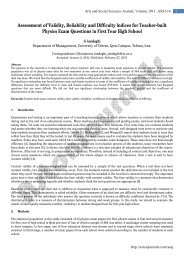
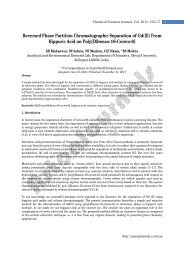
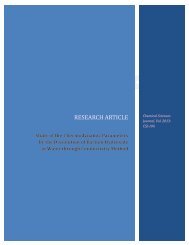
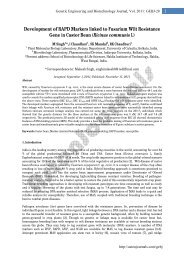

![[1,4]-benzodiazepine-2-one Derivatives as Potent - AstonJournals](https://img.yumpu.com/49117784/1/184x260/14-benzodiazepine-2-one-derivatives-as-potent-astonjournals.jpg?quality=85)
